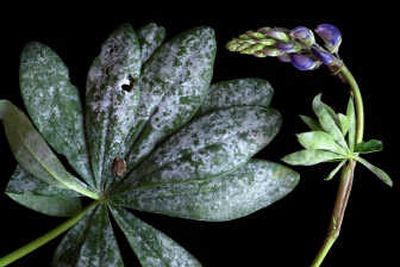Bad year for plant mildew

It’s like a ghost creeping into the garden. Your roses, lupines, phlox and a dozen other plants begin to take on a white, dusty haze ruining the look of otherwise beautiful plants. Welcome to a powdery mildew invasion. And this year it’s particularly bad.
Typically, powdery mildew covers the leaves and tender shoots with a powdery, grayish-white coating. Later in the season small brown or black spots appear. With a heavy infestation, the leaves can be distorted, curled and stunted.
The powdery mildews are caused by a number of types of fungi. Some of the fungi affect only certain plants while others aren’t particular and will invade any available susceptible plant. They grow on the surface of the leaf or stem by sending down root-like structures into the leaf surface to draw nutrients. The white powdery covering that gives the disease its name is actually fungus strands or mycelia and summer spores. The summer spores form chains that are easily picked up by the wind and moved to new hosts. As the mildew gets established, it begins to produce black or brown fruiting bodies throughout the mycelia. These tiny spheres then overwinter on buds, bark and in leaf debris around the plant, emerging the following spring to spread the disease. Cold winters do kill some of the spores but we haven’t had a cold enough winter in a while.
This year has been perfect for the development of mildew. Our days have been relatively warm and a bit humid while the nights have been cool. We haven’t had a lot of rain that would have helped check the spread of the disease.
Getting rid of powdery mildew is a process. Mildew thrives in crowded plantings where humidity is higher and air circulation is poor. It’s important to thin out and move plantings to improve circulation. Affected leaves and stems need to be picked off and put in the trash (not the compost pile). Debris under plants needs to be raked up especially in the fall and put in the trash.
If you have a major mildew problem, it may be best to pull out the plants and replant with mildew resistant varieties.
Surprisingly, one of the best tools for reducing the presence of mildew is to spray your plants with a hard stream of water several times a week. Parts of the fungus can’t tolerate being in a heavy watering. The spores also wash off easily which slows their spread. You might just knock off a few aphids and spider mites in the process.
There are a number of fungicides available to the homeowner to treat powdery mildew but they often work best when they are applied before symptoms appear in the spring and then reapplied every 10 to 14 days. Fungicides do work after an infestation, but it won’t immediately restore the look of your plants.